Tips for Building Raised Garden Bed: Easy and Fun Ideas
Building a raised garden bed can transform your outdoor space into a productive and beautiful area. Whether you’re a beginner or an experienced gardener, creating a raised garden bed offers many benefits, such as improved soil conditions and easier access for planting and harvesting.
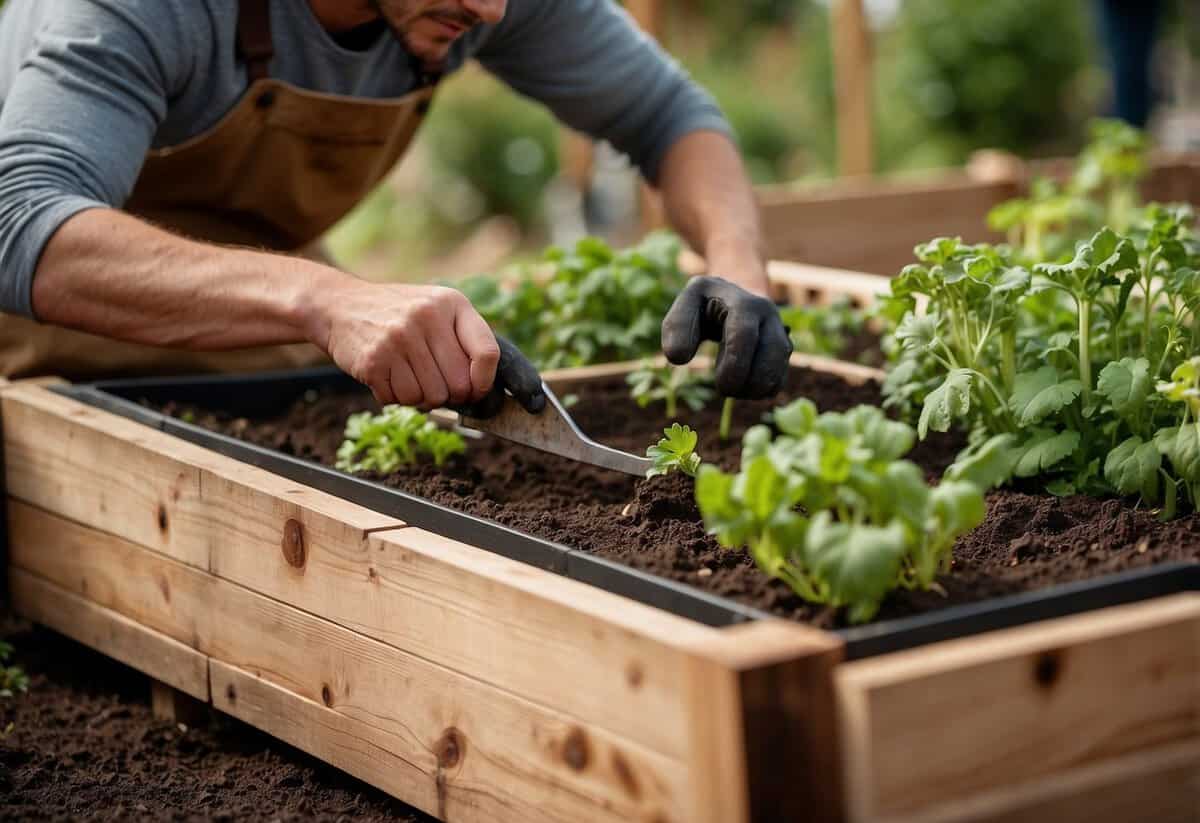
How do you get started with building your own raised garden bed? From selecting the right materials to choosing the perfect location, there are many factors to consider. This guide will help you make informed decisions, ensuring your garden thrives in its new setup.
1) Choose the Right Location

Your raised garden bed needs lots of sunlight. Aim for at least 6-8 hours of direct sunlight per day.
Make sure the spot has good drainage to avoid waterlogged plants.
Avoid areas with tree roots or underground utilities. They can interfere with your garden’s growth.
Position the bed with the short sides facing east-west for even sun exposure.
For the best results, try placing your garden on the south side of buildings or tall structures to maximize sunlight.
2) Select Quality Soil
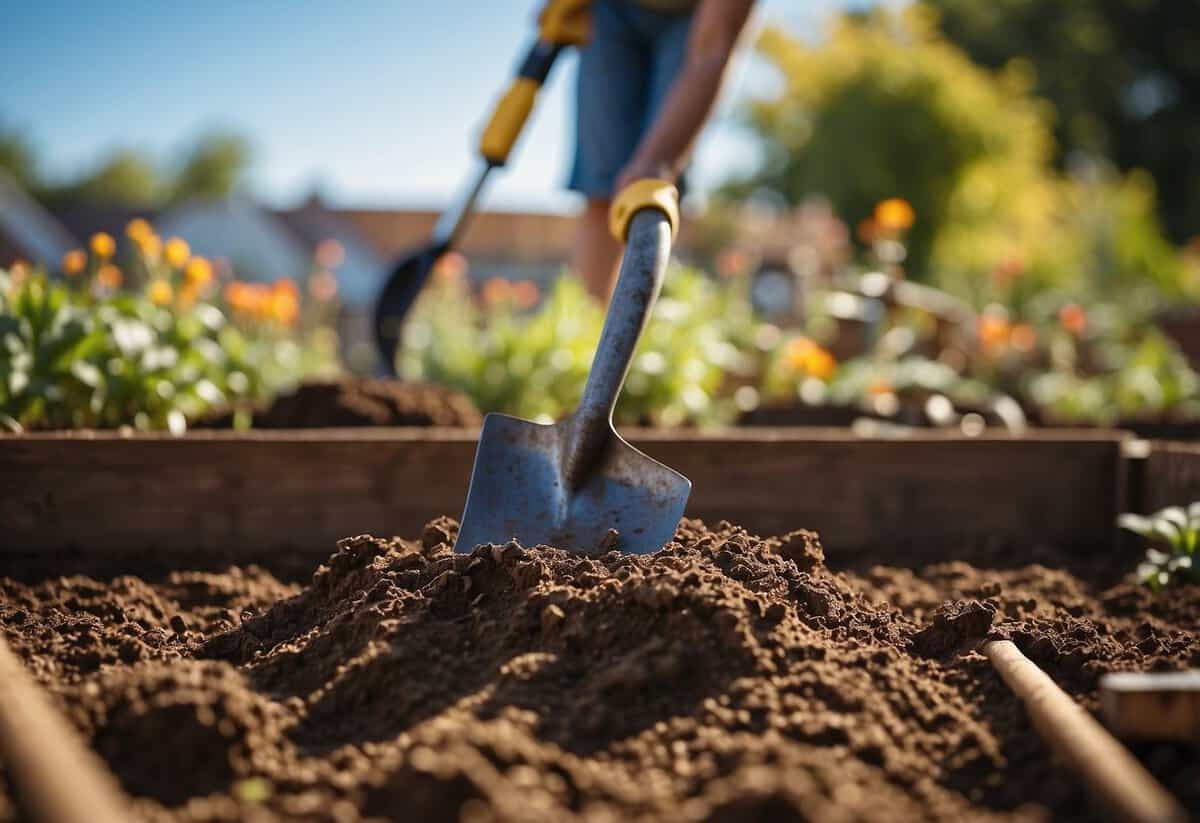
Filling your raised garden bed with quality soil is key to a successful garden. Start with a base layer of organic material like straw or shredded leaves. This helps with drainage.
Next, mix 75% topsoil with 25% compost for a nutrient-rich blend. If your topsoil is sandy, consider increasing the compost to 30% to improve texture. Check out more tips about [quality soil]((https://www.evergreenseeds.com/how-to-fill-a-raised-garden-bed/) for your raised bed.
3) Build with Rot-Resistant Wood

Using rot-resistant wood for your raised garden bed ensures it lasts longer. Cedar and redwood are great choices due to their natural resistance to decay and insects.
Cedar, in particular, has natural oils that prevent moisture from seeping in. It also has a smell that repels pests, making it a favorite for gardeners.
Another good option is redwood. It’s durable and naturally resistant to rot, making your garden bed sturdy and long-lasting. For more details on why cedar is a top choice, check out these benefits.
4) Use Raised Bed Kits
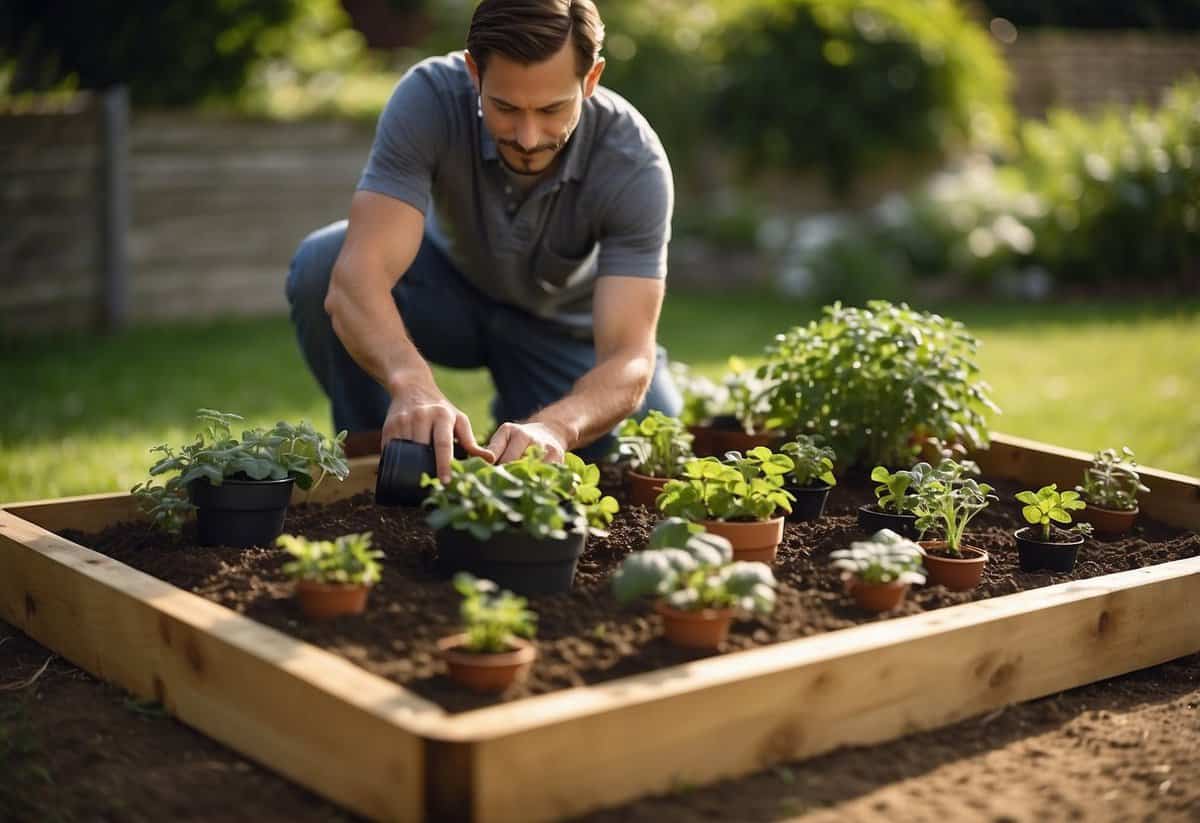
Raised bed kits are a great option if you want to save time and effort. These kits come with all the materials you need and are usually easy to assemble.
You can find these kits online or at your local garden center. They often come in different sizes and materials, so you can choose the one that fits your needs.
One of the advantages of using a kit is that you don’t need to worry about cutting or measuring wood. Everything is pre-cut and ready to go, making the process much simpler. They’re perfect for beginners who may not have the tools or experience to build a bed from scratch.
5) Plan for Proper Drainage

Good drainage is key to a healthy raised garden bed. Start by choosing high-quality soil. Mixing compost with your soil can greatly improve drainage by keeping the soil loose.
You can also add materials like perlite or peat moss to further enhance the soil’s ability to drain. These materials help prevent waterlogging.
Consider placing a layer of mulch on the ground before adding soil. Mulch helps to soak up excess water and ensures even moisture distribution. This can make a big difference in maintaining balanced water levels.
Removing any grass under the bed before starting can also improve drainage significantly.
6) Incorporate Compost

Adding compost to your raised garden bed enriches the soil and boosts plant growth. You can use a 50/50 mix of compost and topsoil. This creates a nutrient-rich base.
For another option, try the Square Foot Gardening Mix. Combine 1/3 compost, 1/3 vermiculite, and 1/3 peat moss. Make sure to mix these well for even distribution.
You can also make compost tea. Fill a container with water, add compost, steep for 24-48 hours, then dilute and apply to your beds. This gives plants an easy nutrient boost.
7) Install Weed Barriers

Unroll the weed barrier fabric and lay it flat across the bottom of the raised garden bed.
Cut the fabric to the size of the bed, leaving some extra material on each side to ensure complete coverage.
Carefully place the cut weed barrier fabric at the bottom of the raised garden bed.
This will help keep weeds from growing up into your garden.
For more details, you can refer to SavanaGarden’s guide.
8) Space Plants Appropriately

Make sure to give your plants enough room to grow. Crowded plants can compete for nutrients and water, leading to poor growth. Check the spacing guidelines for each plant type.
Leave extra space for larger plants like tomatoes and peppers. Smaller plants like lettuce or herbs need less room. Proper spacing helps ensure healthy, strong plants.
9) Add Mulch to Retain Moisture
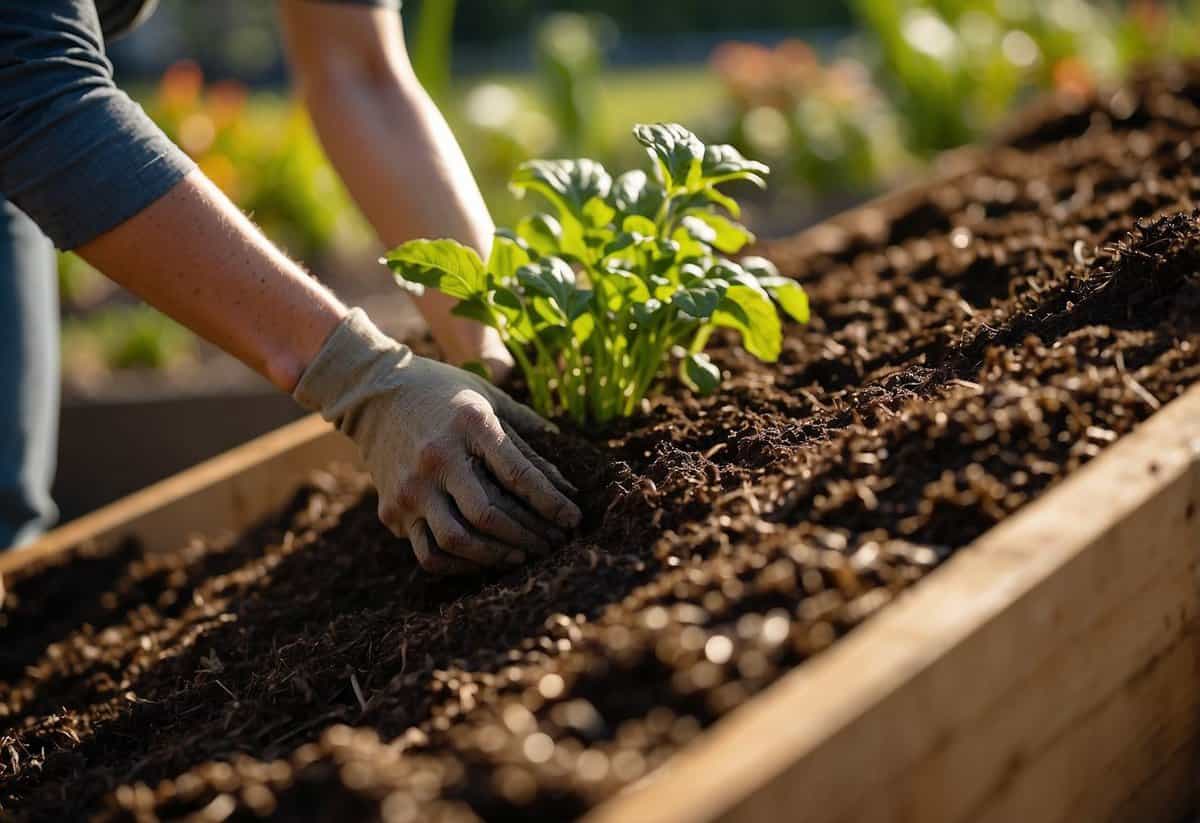
Adding mulch to your raised garden bed is a great way to keep the soil moist. Mulch helps reduce water evaporation, so you won’t need to water as often.
You can use materials like shredded newspaper or wood mulch. These help keep the soil cool and moist, making a better environment for your plants.
Mulch can also prevent weeds from growing, which means your plants get more of the nutrients and water they need to thrive.
10) Utilize Companion Planting
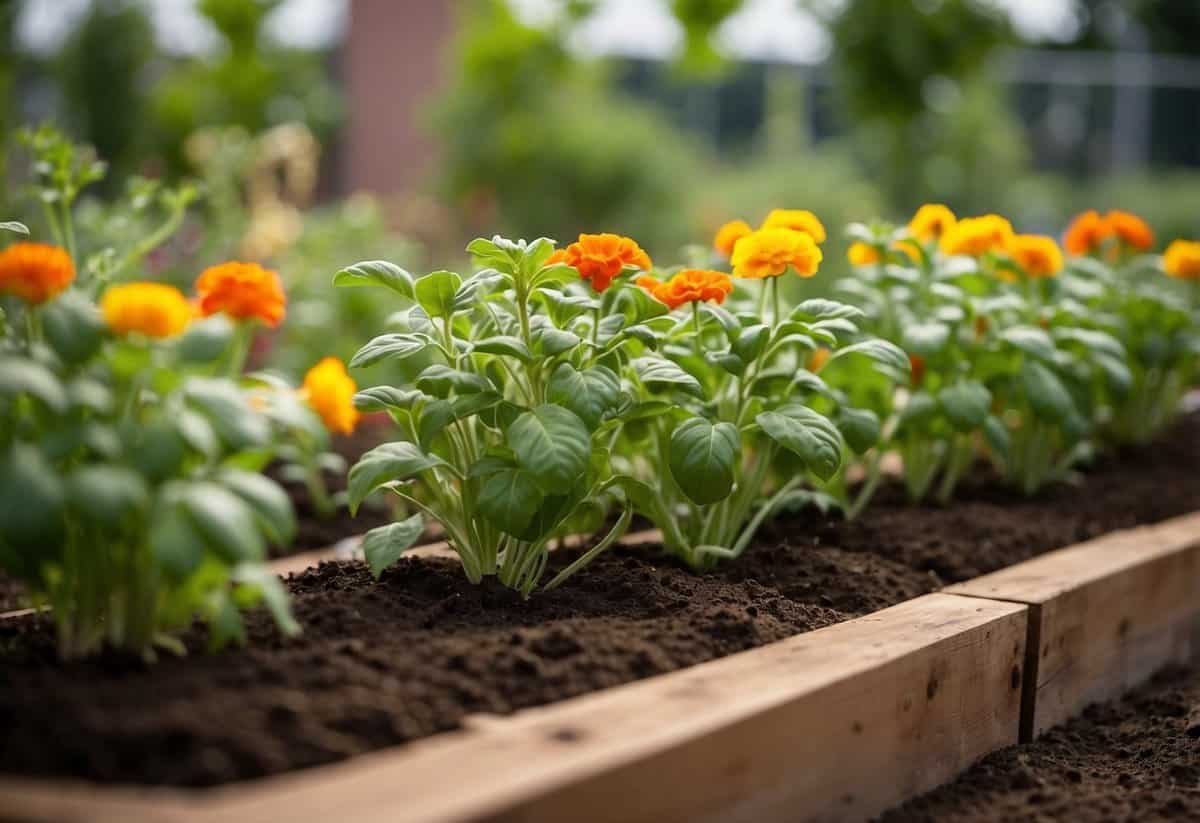
Companion planting boosts your garden’s health. Certain plants grow better together. For example, plant marigolds next to tomatoes to keep pests away.
Grow basil near tomatoes to enhance flavor and repel insects. Planting corn with climbing beans is also beneficial. The beans fix nitrogen for the corn while using the corn for support.
Use these combinations to make your raised garden bed thrive. Incorporating companion planting can decrease pests and improve plant growth. For more tips, consider reading this companion planting guide for raised beds.
Choosing the Right Material

Selecting the best material for your raised garden bed can make a big difference in durability, cost, and overall success. Wood, stone, and metal each have their pros and cons.
Wood
Wood is a popular choice for raised garden beds because it is accessible and easy to work with. Cedar and cypress are great options because they naturally resist rot, which helps your bed last longer. Avoid pressure-treated wood, as it may contain harmful chemicals.
Wooden beds are also aesthetically pleasing and can blend well with most garden designs. The cost of wood can vary, but it is generally affordable, especially if you choose reclaimed wood. Regular maintenance, like re-staining, can extend the life of your wooden bed.
Stone
Stone is another excellent option for raised garden beds. It is very durable and can last for many years without much maintenance. You can use different types of stone, such as flagstone or bricks, to create a strong and attractive garden bed.
While stone can be more expensive and labor-intensive to install, it offers great stability and an elegant look. Stone beds also require less upkeep compared to wood, as they won’t rot or attract pests. If you’re looking for a long-term solution that adds beauty to your garden, stone is a fantastic choice.
Metal
Metal raised garden beds are gaining popularity for their modern look and durability. You can choose between different types of metals, including corten steel and galvanized steel. These materials are resistant to rust and can last for many years.
Some metal garden beds come in easy-to-assemble kits, making them convenient. Metal beds can become hot in direct sunlight, which may affect your plants, so placing them in a partially shaded area can help. They are also typically more expensive than wood but offer a sleek aesthetic and long-lasting performance.
Preparing the Ground

It’s essential to choose the right location and properly prepare the soil to ensure your raised garden bed thrives.
Site Selection
First, find the best spot in your yard. Look for an area that gets at least six hours of direct sunlight daily. Most vegetables need this amount of light to grow well. Observe your yard at different times of the day to see where the sunlight hits the longest.
Next, ensure the ground is even. If it’s sloped, consider terracing or using retaining walls to level it out. This helps prevent water from pooling in some areas and leaving others dry.
Lastly, leave enough space between beds. Aim for pathways that are wide enough for you to walk through comfortably, especially if you’ll be using a wheelbarrow or other garden tools.
Soil Preparation
Begin by laying a base layer to prevent weeds and grass from growing into your bed. Use cardboard or newspaper at the bottom to smother unwanted growth. Spread soil over this layer, but don’t overload it.
For the best results, use a mix of topsoil and compost. A good ratio is about 75% topsoil to 25% compost. This combination provides the necessary nutrients for your plants. If your local topsoil is sandy, add some clay soil to improve texture.
Mix in some well-rotted manure or leaf mold to boost nutrient levels further. Your goal is a rich, crumbly soil that holds moisture well and supports healthy root growth.
Building the Structure

When building a raised garden bed, it’s important to focus on measuring and cutting the materials accurately and assembling the frame correctly. This ensures a sturdy and long-lasting garden bed.
Measuring and Cutting
Start by measuring the area where you’ll place your raised garden bed. Make sure it’s level and gets enough sunlight. Use a tape measure to get the exact dimensions.
Next, gather the materials. Common choices include untreated wood, cedar, or composite. Measure the wood to the desired length and mark it. Use a saw to cut the boards to size.
It’s crucial to cut the wood accurately. This will help the pieces fit together snugly. Doing this right ensures the structure will be square and stable.
Check your measurements twice before cutting to avoid mistakes. It’s better to cut a little longer at first and trim down if needed. Sand the edges of the cut pieces to avoid splinters and ensure a clean fit.
Assembling the Frame
To assemble the frame, start by laying out your cut boards on a flat surface. Position the 4×4 corner posts at each corner. These posts will provide extra stability.
Attach the boards to the corner posts using screws or nails. Use at least two screws per board to make sure they are secure. It’s helpful to pre-drill the screw holes to prevent the wood from splitting.
Make sure the frame is square before tightening all the screws. Use a carpenter’s square to check each corner. If not square, adjust the boards until they align properly.
Finally, once the frame is secure, position it in your garden area. If the ground is uneven, you can dig a bit to level the frame. Secure the frame by pushing it slightly into the ground.
Now your frame is ready for soil and plants! Ensuring your structure is well-built helps your garden thrive.







